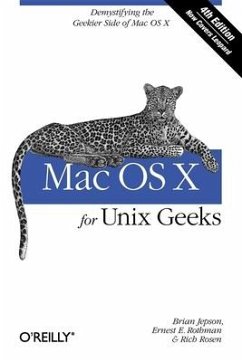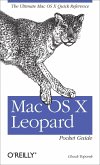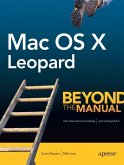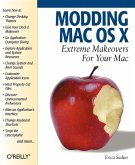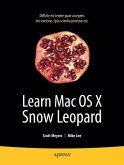If you're a developer or system administrator lured to Mac OS X because of its Unix roots, you'll quickly discover that performing Unix tasks on a Mac is different than what you're accustomed to. Mac OS X for Unix Geeks serves as a bridge between Apple's Darwin OS and the more traditional Unix systems. This clear, concise guide gives you a tour of Mac OS X's Unix shell in both Leopard and Tiger, and helps you find the facilities that replace or correspond to standard Unix utilities.
You'll learn how to perform common Unix tasks in Mac OS X, such as using Directory Services instead of the standard Unix /etc/passwd and /etc/group, and you'll be able to compile code, link to libraries, and port Unix software using either Leopard and Tiger. This book teaches you to:
- Navigate the Terminal and understand how it differs from an xterm
- Use Open Directory (LDAP) and NetInfo as well as Directory Services
- Compile your code with GCC 4
- Port Unix programs to Mac OS X with Fink
- Use MacPorts to install free/open source software
- Search through metadata with Spotlight's command-line utilities
- Build the Darwin kernel
And there's much more. Mac OS X for Unix Geeks is the ideal survival guide to tame the Unix side of Leopard and Tiger. If you're a Unix geek with an interest in Mac OS X, you'll soon find that this book is invaluable.
You'll learn how to perform common Unix tasks in Mac OS X, such as using Directory Services instead of the standard Unix /etc/passwd and /etc/group, and you'll be able to compile code, link to libraries, and port Unix software using either Leopard and Tiger. This book teaches you to:
- Navigate the Terminal and understand how it differs from an xterm
- Use Open Directory (LDAP) and NetInfo as well as Directory Services
- Compile your code with GCC 4
- Port Unix programs to Mac OS X with Fink
- Use MacPorts to install free/open source software
- Search through metadata with Spotlight's command-line utilities
- Build the Darwin kernel
And there's much more. Mac OS X for Unix Geeks is the ideal survival guide to tame the Unix side of Leopard and Tiger. If you're a Unix geek with an interest in Mac OS X, you'll soon find that this book is invaluable.
"Mac OS X Tiger for Unix Geeks [...] wendet sich an die Spezialisten und Anwender mit Erfahrung, die tief im Innern des Unix-Kernes arbeiten wollen." -- Mac Life Empfehlung 4/2006
"Immer mehr Unix Geeks steigen auf den Mac um. [...] Trotzdem scheint ein Mac doch irgendwie anders zu ticken. Da hilft Mac OS X for Unix Geeks. Der Titel ist vortrefflich gewählt, denn das Buch geht auf genau die Fragen ein, die sich einem Unix Benutzer auf dem Mac stellen.
Das Buch beginnt natürlich mit einem Kapitel zu Terminals unter Mac OS X. Ein guter Start für den Rundgang durch das System, der im ersten und umfangreichsten Teil Getting Around zu finden ist. Dabei vermitteln die Autoren auf leicht lesbare Weise, was an Mac OS X anders ist. Besonders interessant sind die Artikel zu Directory Services und NetInfo, die einige Aha-Erlebnisse bergen. Darüber hinaus bietet dieser Teil nützliche Informationen zum Dateisystem HFS+, zum Boot-Vorgang und zur Shell-Sicht auf Mac OS X.
Der zweite Teil Building Applications leistet Unix Programmierern wertvolle Dienste. Denn auch im Bereich der Compiler und Bibliotheken ist auf dem Mac einiges anders. [...]" -- Felix Hassert, Buchtest.com, 11/2005 "Sie [Jepson und Rothman] weisen erfahrenen Unix-Nutzern den Weg und halten sich nicht weiter mit Grundlegendem auf. Ohne Umschweife erklären sie die Besonderheiten des Dateisystems HFS+ und von Spotlight, dem Apple-eigenen Mechanismus zur Lokalisierung von Dateien. Dann wenden sie sich der Konfiguration des Grafiksystems X11 zu und dröseln detailliert die Feinheiten auf, die beim Erzeugen eigener Programme und Bibliotheken in C/C++ und Objective-C zu beachten sind. Viel Raum widmen sie auch den bekanntesten Paketmanagern (Fink, DarwinPorts) und schildern, wie man Pakete installiert und auch selbst erzeugt.
Der englischsprachige Titel bietet Geeks eine schnelle Orientierungshilfe." -- Maik Schmidt, c't Heft 19/2005
"Mac OS X for Unix Geeks ist ein ideales Nachschlagewerk für alle, die der englischen Sprache mächtig sind und sich intensiv mit dem Unix-Innenleben des Leoparden beschäftigen wollen. Denn unter der grafischen Oberfläche von Mac OS X 10.5 werkelt ein mächtiger Unterbau, den Entwickler und Systemadministratoren mit diesem Buch leicht in den Griff kriegen." -- Mac Life, März 2009
"Immer mehr Unix Geeks steigen auf den Mac um. [...] Trotzdem scheint ein Mac doch irgendwie anders zu ticken. Da hilft Mac OS X for Unix Geeks. Der Titel ist vortrefflich gewählt, denn das Buch geht auf genau die Fragen ein, die sich einem Unix Benutzer auf dem Mac stellen.
Das Buch beginnt natürlich mit einem Kapitel zu Terminals unter Mac OS X. Ein guter Start für den Rundgang durch das System, der im ersten und umfangreichsten Teil Getting Around zu finden ist. Dabei vermitteln die Autoren auf leicht lesbare Weise, was an Mac OS X anders ist. Besonders interessant sind die Artikel zu Directory Services und NetInfo, die einige Aha-Erlebnisse bergen. Darüber hinaus bietet dieser Teil nützliche Informationen zum Dateisystem HFS+, zum Boot-Vorgang und zur Shell-Sicht auf Mac OS X.
Der zweite Teil Building Applications leistet Unix Programmierern wertvolle Dienste. Denn auch im Bereich der Compiler und Bibliotheken ist auf dem Mac einiges anders. [...]" -- Felix Hassert, Buchtest.com, 11/2005 "Sie [Jepson und Rothman] weisen erfahrenen Unix-Nutzern den Weg und halten sich nicht weiter mit Grundlegendem auf. Ohne Umschweife erklären sie die Besonderheiten des Dateisystems HFS+ und von Spotlight, dem Apple-eigenen Mechanismus zur Lokalisierung von Dateien. Dann wenden sie sich der Konfiguration des Grafiksystems X11 zu und dröseln detailliert die Feinheiten auf, die beim Erzeugen eigener Programme und Bibliotheken in C/C++ und Objective-C zu beachten sind. Viel Raum widmen sie auch den bekanntesten Paketmanagern (Fink, DarwinPorts) und schildern, wie man Pakete installiert und auch selbst erzeugt.
Der englischsprachige Titel bietet Geeks eine schnelle Orientierungshilfe." -- Maik Schmidt, c't Heft 19/2005
"Mac OS X for Unix Geeks ist ein ideales Nachschlagewerk für alle, die der englischen Sprache mächtig sind und sich intensiv mit dem Unix-Innenleben des Leoparden beschäftigen wollen. Denn unter der grafischen Oberfläche von Mac OS X 10.5 werkelt ein mächtiger Unterbau, den Entwickler und Systemadministratoren mit diesem Buch leicht in den Griff kriegen." -- Mac Life, März 2009

